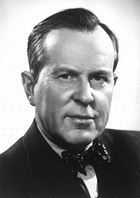 |
Lester B. Pearson Biography |
| Behind The Camera | | Canvas & print | | Military | | Models | | Movies | | Music | | Political | | Porn | | Other | |
| Science & Technology | | Sports | | TV | | Writers | | the big list |

Lester B. Pearson |
|
| Birthdate: | April 23, 1897 |
| Category: | Political |
Lester, Bowles, Pearson was born on April 23, 1897 in Newtonbrook, Ontario, which is now part of Toronto. Pearson was a former baseball and hockey player. He married Maryon Elspeth Moody on August 22, 1925. Lester was the son of Edwin Arthur Pearson, a Methodist Minister, and Anne Sarah Bowles Pearson. Lester had an older brother, Marmaduke and a younger brother, Vaughan. Edwin had a great interest in sports, especially baseball. Edwin then passed on his love of sports to Lester. Lester was a star athlete and an excellent student. At eighteen, Lester left his father's parsonage to be a stretcher -bearer in the First World War. Pearson was shattered by his wartime experiences, and had difficulty settling down on his return. He studied law, worked as a sausage stuffer, won an Oxford scholarship, and came home to be a history professor and football coach. In 1913, Pearson entered the University of Toronto. He majored in history. He took his B.A. at the University of Toronto and his M.A. at the Oxford University. In 1928, still unsettled, he joined the Foreign Service.
Some of the important dates in Lester's Canadian Political Career were when he joined External Affairs as First Secretary in Ottawa, Ontario on August 28, 1928. In 1935 to 1941, he served in High Office of the Commissioner for Canada in London, UK. In May 1941, he became the Assistant Undersecretary of State, External Affairs, Ottawa. In June 1942, he was the Minister - Counselor, Canadian Legation in Washington, D.C. In July of 1944, Lester was promoted to Minister Plenipotentiary, Canadian Legation in Washington, D.C. In January 1958 to the spring of 1968, Lester was the Liberal Party Leader. In April 22, 1963 to April 1968 Lester was the Prime Minister of Canada. In the spring of 1968, Pearson retired from politics. For three years after his political career, he was a professor and chancellor at Carleton University in Ottawa.
Some of the important dates in Lester Pearson's United Nations Career will be highlighted. In 1935, he participated in pre-UN international conferences on issues such as disarmament and international law and the League of Nations. On July 1943 to October 1945, Lester was the Chairman, and Interim Committee on Food and Agriculture. He actively made Canada's views known through informal channels to the exclusive Dumbarton Oaks Conference (four great nations discussing concrete plansto establish a formal United Nations organization) in August 21 1944 to October 7 1944. In 1952 to 1953 he was President of the UN General Assembly (seventh Session.) The main focus of the assembly was to resolve Korean conflict, ultimately resulted in armistice. In 1957 Lester was awarded the Nobel Peace Prize proudly accepted it in December of 1957.
Lester Pearson was Canada's fourteenth Prime Minister, and foremost diplomat. Lester Pearson was a man of deep and passionate convictions. His vision of Canada as a force for international peace, medication, and good would help redefine our view of ourselves. September 1948, Pearson was appointed secretary of state for external affairs of Canada. Canadian Cabinet members must be members of Parliament, so Pearson ran for a seat in the House of Commons the following month.
A man uneasy with ambition, who shunned the flamboyance of his archrival Diefenbaker, Pearson nevertheless, competed for the most prestigious prize in Canadian political life. World recognition brought him the Nobel Peace Prize, yet in his battle to maintain independence for his country he deliberately incurred the wrath of its powerful traditional allies, particularly Lyndon Johnson whom he heartily disliked. He was oddly unprepared personally to take on Canada's highest political office, and led the Liberal Party to the worst defeat in its history. He went on the sponsor astonishing, far-reaching changes in Canadian society - bilingualism, biculturalism, Medicare, modern Canadian nationalism, and co-operative federalism were all innovations of Pearson's years. While he had been called our greatest Prime Minister by some, others saw him as the leader of a government that created many of Canada's discontents, and crises and scandals that swirled about him. Most paradoxically of all perhaps, this unassuming man became a national icon, winning a last place in the hearts and minds of a whole generation of Canadians. Share on Facebook
Last updated: 09-09-07 Hits: 11050
Recent Reviews
- War Horse 2012-01-02
- Legion 2010-01-23
- Zombieland 2009-10-02
- The Martyr's Oath: The Apprenticeship of a Homegrown Terrorist 2009-08-20
- Bachman Cummings 2009-06-22
- Star Trek 2009-05-03
- X-Me Origins: Wolverine 2009-05-01
- Soloist 2009-04-24
Canadian Content
Latest Topics in Canadian Forums
- Trudeau says Sask. premier is fighting CRA on carbon tax, wi
[Current Events] Last post by DrCaleb


